Looking at the exhibition in Changsha
I went to Changsha for three days during the National Day holiday this year and visited several exhibition halls.
There were many people at Hengyang Railway Station on the morning of the 1st, and there were long queues in front of more than a dozen ticket collection machines. Arriving at Changsha Railway Station at noon, the manual ticket sales at the subway station were all put on the ground. Although the queue was long, the order was good.
I went shopping in the afternoon, focusing on the fireworks on Juzizhou at night. The performance time was 7:30-7:50 p.m. We arrived an hour early, and the riverside was already full of people, but we still stood in the first row across the road from Dufu Jiangge. My daughter said that this is the third time she has watched fireworks in Changsha. This time it is the best and the best location. Later, I looked at the pictures on the Internet. Except for the incomplete view of the low-altitude fireworks and the reflection of the river surface, this location was not bad. The fireworks were dazzling, the crowd was surging, and cries of exclamations could be heard from the crowd from time to time. I suddenly remembered a passage I saw at an unknown time and place,"It's like fireworks blooming in the dark night, warm and powerful." The author used it to describe something that has been forgotten, but this sentence is still in my heart and sometimes I think of it for no reason.

Photo description: No. 1, Du Fujiang Pavilion. Juzizhou Fireworks
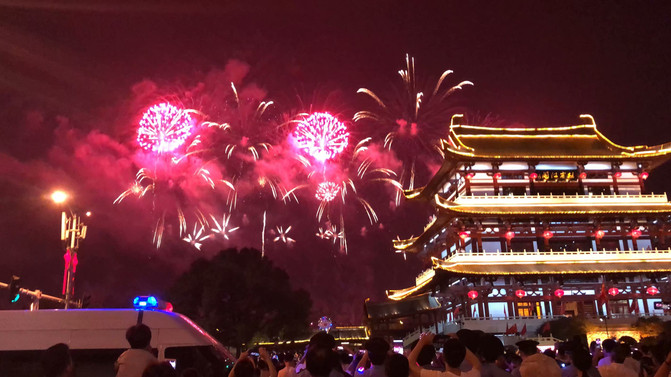
Photo description: No. 1, Du Fujiang Pavilion. Juzizhou Fireworks

Photo description: No. 1, Du Fujiang Pavilion. Juzizhou Fireworks

Photo description: No. 1, night view of the pedestrian street.
It is said that there were 100,000 people who had to take the subway back that night. How could they squeeze in at this time? We went to "Wu Susheng" on the roadside to buy some cakes, sat and rested, and watched the crowd on the road outside the store receded. It was not until ten o'clock in the evening that the crowd became a little thinner. When we arrived at the subway station, there was another queue.
I stayed in my daughter's dormitory at night, and the two of us slept in her small bed. I also recalled to her that we often did this back then. Three of us even slept on the upper bunk, and they almost couldn't fold it up.
Lin Keke's snail noodles are famous and can't be missed. It's for breakfast, but my daughter disliked the taste, so I had to taste it myself. It was okay, but it wasn't as delicious as the legend said.

Photo description: Breakfast No. 2, snail noodles next to Lin Keke.
We first went to the Meixi Lake International Culture and Art Center, walked around, and looked at the exterior of the building. The all-white building was very characteristic and large in scale, but there was nothing to see in broad daylight. There were no lights or fountains.
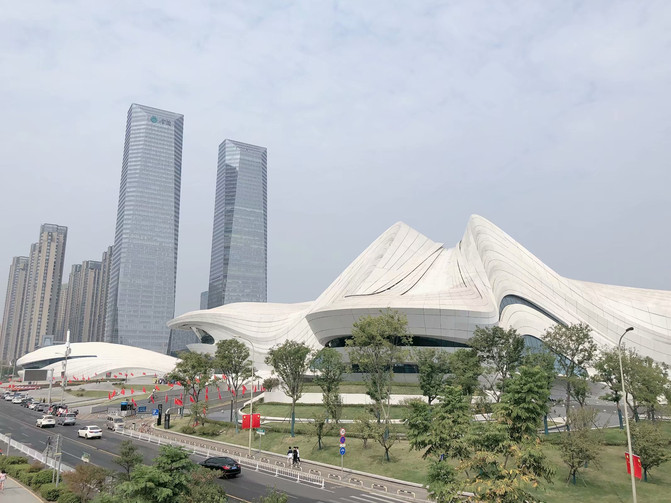
Photo description: No. 2, Meixi Lake.

Photo description: No. 2, Meixi Lake.
Among the Changsha Folk Exhibition Halls, the more famous ones are the "Xie Zilong Image Art Museum" and the "Li Zijian Art Museum", both located in Yanghu and next to each other. We first went to the "Xie Zilong Image Art Museum". There are four fee-paying exhibitions being held, with a joint ticket of 100 yuan and a student ticket of 80 yuan. To be honest, although the works on display are all works of famous artists, I can't understand the beauty of them. However, taking some photos inside still seems more artistic. Probably because we were there at the right time and the sun was relatively strong outside, so the light and shadow changes in the museum were very interesting, especially in the venue on the third floor. I saw that most young people bought tickets to come in just to take photos. -Except for me, no one over 30 years old was seen.

Photo description: Exhibition held at Xie Zilong Image Art Museum

Photo description: No. 2, Xie Zilong Image Art Museum. "Parallel-Evan. Olaf."

Photo description: No. 2, Xie Zilong Image Art Museum. "Parallel-Evan. Olaf." Keyhole

Photo description: No. 2, Xie Zilong Image Art Museum. "Wandering alone-Eric. Brett Photography Exhibition "

Photo description: No. 2, Xie Zilong Image Art Museum. "Poetry by contrast-Bruno. Hekia."

Photo description: No. 2, Xie Zilong Image Art Museum.

Photo description: No. 2, Xie Zilong Image Art Museum. "Parallel-Evan. Olaf."

Photo description: No. 2, Xie Zilong Image Art Museum. "Poetry by contrast-Bruno. Hekia."
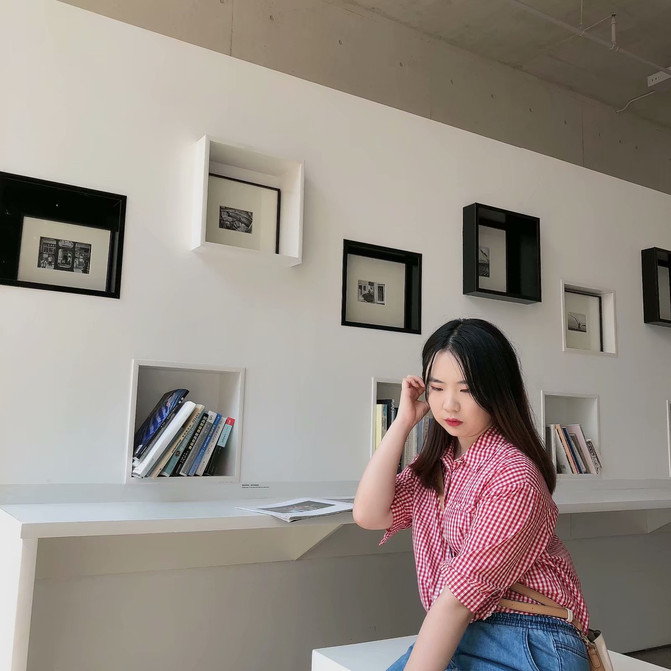
Photo description: No. 2, Xie Zilong Image Art Museum.

Photo description: No. 2, Xie Zilong Image Art Museum. "Poetry by contrast-Bruno. Hekia."

Photo description: No. 2, Xie Zilong Image Art Museum. "Poetry by contrast-Bruno. Hekia."

Photo description: No. 2, Xie Zilong Image Art Museum.

Photo description: No. 2, Xie Zilong Image Art Museum.
There are also free exhibitions, among which IKEA has made a "flash" because an IKEA will open near the end of the year and members can now be joined.

Photo description: No. 2, Xie Zilong Image Art Museum. "IKEA. Flash "
Compared with the modern and concise appearance of the "Xie Zilong Image Museum", the appearance of the "Li Zijian Art Museum" is more designed and larger in scale. In 2017, it was certified by the British World Records Certification Agency (WRCA) as the "World's Largest Individual Art Museum for Artists". Master Xingyun once personally laid the foundation stone, which houses his permanent exhibition hall and bookstore. In the center of his exhibition hall is Mao Zedong's "Qinyuanchun. Snow." Li Zijian's own oil paintings also have a permanent exhibition hall, most of which are large portraits. In comparison, I still like "Liu Kaiqu and the 20th Century Chinese Art Exhibition"(Liu Kaiqu: embossed of the Monument to the People's Heroes, etc.), and I especially like his teacher Jean. Park She's works are very tense and impactful.

Photo description: No. 2, Li Zijian Art Museum.

Photo description: No. 2, Li Zijian Art Museum. mind space
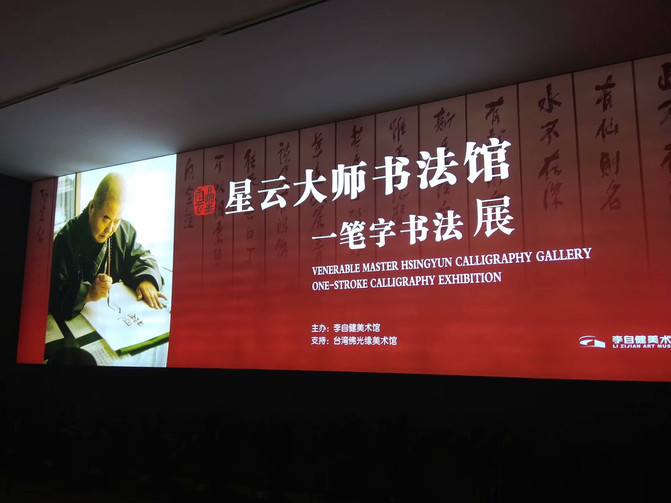
Photo description: No. 2, Li Zijian Art Museum. Master Xingyun calligraphy exhibition.

Photo description: No. 2, Li Zijian Art Museum. Master Xingyun calligraphy exhibition.

Photo description: No. 2, Li Zijian Art Museum. Master Xingyun calligraphy exhibition.

Photo description: No. 2, Li Zijian Art Museum. Li Zijian's exhibition.

Photo description: No. 2, Li Zijian Art Museum. Li Zijian's exhibition.

Photo description: No. 2, Li Zijian Art Museum. Li Zijian's exhibition.

Photo description: No. 2, Li Zijian Art Museum. Li Zijian's exhibition.

Photo description: No. 2, Li Zijian Art Museum. Li Zijian's exhibition.

Photo description: No. 2, Li Zijian Art Museum. Liu Kaiqu and the 20th Century Chinese Art Exhibition

Photo description: No. 2, Li Zijian Art Museum. Liu Kaiqu and the 20th Century Chinese Art Exhibition

Photo description: No. 2, Li Zijian Art Museum. Liu Kaiqu and the 20th Century Chinese Art Exhibition. Pu She, Teacher Liu Kaiqu

Photo description: No. 2, Li Zijian Art Museum. Liu Kaiqu and the 20th Century Chinese Art Exhibition. Park's Works
When I went to Changsha this time, I wanted to visit the Provincial Museum most. I always wanted to go after the completion of the new museum, mainly to see the display of the Han tomb in Mawangdui. The last time I went to see it was when I was a graduate intern in Changsha. At that time, the exhibition conditions in various aspects were still a bit rough. My daughter booked a ticket in the middle of the night for two consecutive nights before she got the appointment. Arriving at the Provincial Museum at 9 a.m. on the 3rd, people with reservations and unreservations lined up separately, along the sidewalk to the entrance of Martyrs Park and forward. There were also people with luggage in the line. Seeing this attitude, we decided to go to Martyrs Park first. Martyrs Park is not big, with a playground and boating on the lake. There is nothing else to visit, but there is a blind date corner.

Photo description: No. 3, Martyrs Park

Photo description: No. 3, Martyrs Park
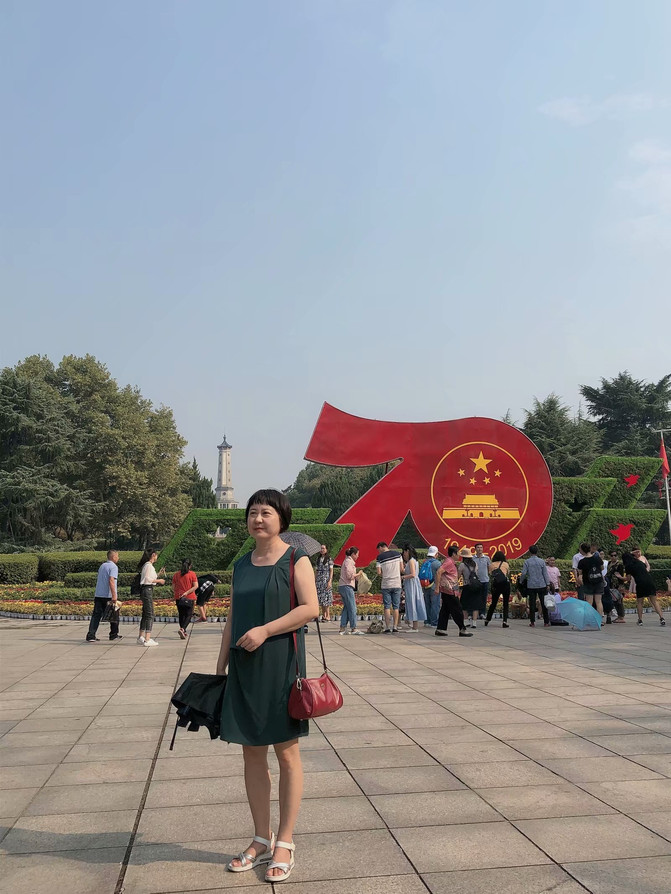
Photo description: No. 3, Martyrs Park

Photo description: No. 3, Martyrs Park

Photo description: No. 3, Martyrs Park. blind date corner.
When we arrived at 12 noon, there was almost no one in line at the "reserved" end, but there were still many people in the exhibition hall. Needless to say, the Han tombs more than 2000 years ago were rich and well preserved. Coupled with the display of modern scientific and technological means, it is amazing. I repeatedly asked the staff whether it was the original, and the answer was yes. If it was a copy, it would be clearly marked (very few copies were seen). I met a commentator and listened to a passage about "Seven Tripods": According to the etiquette system at that time, the emperor used nine tripods, and the princes used seven tripods. The owner of the tomb was the wife of the Prime Minister of Changsha State, so only five tripods should be used (only the King of Changsha could use seven tripods). The reason why the prime minister was appointed by the emperor rather than the King of Changsha, he could dispose of the king in an emergency.

Photo description: No. 3, Provincial Museum. "Han Tomb Exhibition at Mawangdui, Changsha", Seven Tripods

Photo description: No. 3, Provincial Museum. "Han Tomb Exhibition at Mawangdui, Changsha", Tableware

Photo description: No. 3, Provincial Museum. "Han Tomb Exhibition at Mawangdui, Changsha", bathing equipment, equivalent to "washbasin"

Photo description: No. 3, Provincial Museum. "Han Tomb Exhibition at Mawangdui, Changsha", a group of performance figures: first row of singers, second row of dancers, and third row of musicians

Photo description: No. 3, Provincial Museum. "Han Tomb Exhibition at Mawangdui, Changsha", incense burner, cover is made of bamboo and covered with silk

Photo description: No. 3, Provincial Museum. "Han Tomb Exhibition at Mawangdui, Changsha"

Photo description: No. 3, Provincial Museum. "Han Tomb Exhibition at Mawangdui, Changsha"

Photo description: No. 3, Provincial Museum. "Han Tomb Exhibition at Mawangdui, Changsha"

Photo description: No. 3, Provincial Museum. "Han Tomb Exhibition at Mawangdui, Changsha"
There are several other exhibitions in the Provincial Exhibition Hall that we took a look.

Photo description: No. 3, Provincial Museum. "Excited sounds in the Xiangjiang River-Xiaoxiang Guqin Culture Exhibition"
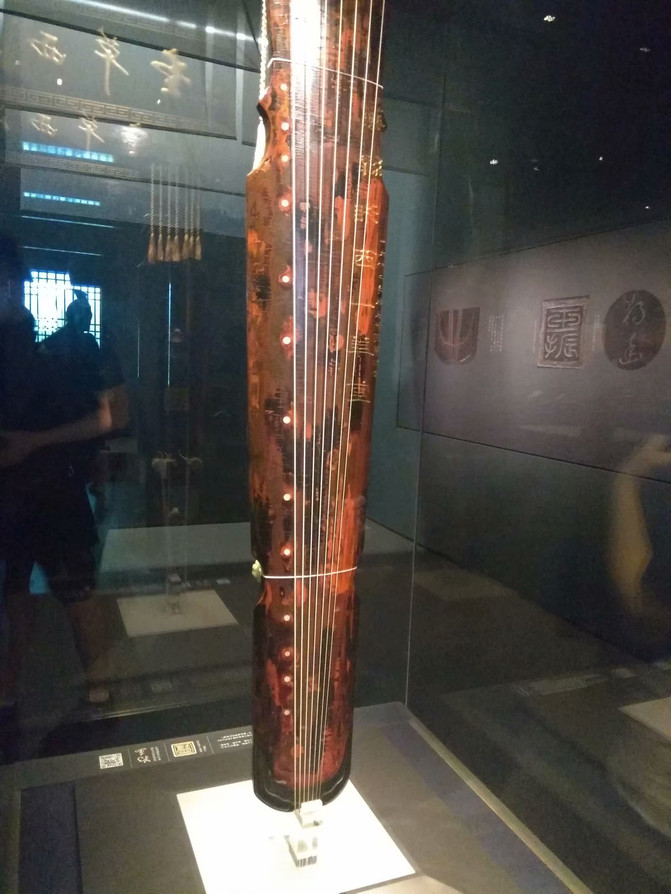
Photo description: No. 3, Provincial Museum. "Excited sounds in the Xiangjiang River-Xiaoxiang Guqin Culture Exhibition"
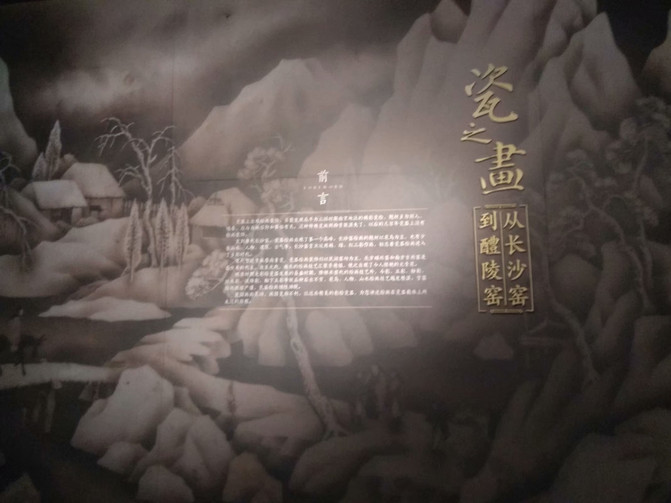
Photo description: No. 3, Provincial Museum. "Porcelain Painting-From Changsha Kiln to Liling Kiln"

Photo description: No. 3, Provincial Museum. "Porcelain Painting-From Changsha Kiln to Liling Kiln"

Photo description: No. 3, Provincial Museum. "Porcelain Painting-From Changsha Kiln to Liling Kiln"

Photo description: No. 3, Provincial Museum. "Porcelain Painting-From Changsha Kiln to Liling Kiln"

Photo description: No. 3, Provincial Museum. "Porcelain Painting-From Changsha Kiln to Liling Kiln"

Photo description: No. 3, Provincial Museum. "Painting My Own Painting-Exhibition of Qi Baishi's Paintings in the Collection"

Photo description: No. 3, Provincial Museum. "Painting My Own Painting-Exhibition of Qi Baishi's Paintings in the Collection"

Photo description: No. 3, Provincial Museum. "Painting My Own Painting-Exhibition of Qi Baishi's Paintings in the Collection"
I originally planned to leave Changsha on the 4th, but my daughter's roommate came back, so I changed my ticket. After staying in Changsha for the past few days, I feel that there are people everywhere, especially the places where I eat are popular. My daughter calls herself a "bar" in Changsha and insists on taking me to eat what she thinks is the best. Almost everyone has to wait for a table, with the most waiting time for more than 70 tables. Milk tea is also very popular, and every "tea beauty" restaurant has to queue up.
Previous Article:Marathon Travels 8 ~ Just in their prime, thousands of people compete to run the head of Juzizhou, remember the 2019 Changsha International Marathon
